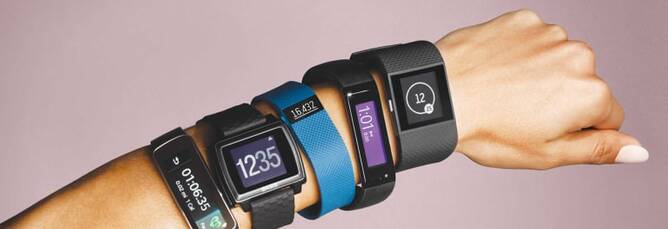I have a love hate relationship with my Fitbit. It is a bit too big for my arm and seems to continually need recharging. But on the other hand, the information that it gives me on how healthy I am, how much sleep I get and how much exercise I have done - and then compares it to other woman my age is very motivating!
As this article outlines, insurers can use this information in negative ways.
What might happen in the future with insurance cover and the use of artificial intelligence
However, there are insurers who are looking at using this technology in a positive manner - and reducing premiums if people actively use technology.
There has been a lot of interest in the development of wearable health technology, and rightly so. It is a rapidly evolving market, with potential for a large and positive impact on life.
The most common example is a Fitbit. But there are many brands of devices, plus apps on phone, or smartwatch that track certain health metrics. These started by tracking just steps, but then they grew – many track heart rate and sleep as well. The companion apps that are installed on smartphones typically allow for other data to be added.
Connected wi-fi scales allow the easy, regular addition of weight and body composition tests. Combining the data yields other insights – an overall estimate of heart health is possible.
There some exciting new products heading for the market as well. A smart mirror is being developed that analyses your body shape and provides more health insights. A device you breath into helps with analysis of diet. There will be more, and they will get better and better. Accuracy will improve, and the hassle factor of charging yet more small gizmos will diminish as battery life and new charging methods emerge.
Over the last 18 months different (non NZ) insurers have changed their underwriting policies to rely on these devices - see these articles below. There is no indication that New Zealand insurers will be introducing the reliance on these devices just yet however.
John Hancock Will Only Sell Interactive Life Insurance with Fitness Data Tracking
John Hancock, one of the oldest and largest North American life insurers, will stop underwriting traditional life insurance and instead sell only interactive policies that track fitness and health data through wearable devices and smartphones, the company said on Wednesday.
The move by the 156-year-old insurer, owned by Canada’s Manulife Financial Corp., marks a major shift for the company, which unveiled its first interactive life insurance policy in 2015. It is now applying the model across all of its life coverage.
The next frontier in insurance
Picture the scenario: You decide to increase your life insurance, but during the medical screening it turns out you have high cholesterol.
The insurance company overlooks the fact that you are in a much better shape than your peers or that there is no history of anybody in your family ever suffering from heart conditions.
It decides to charge you a 50% premium to cover its risk of you suffering a fatal heart attack, in effect losing your business.
Fortunately, the days of blanket penalisation for specific health markers are slowly drawing to an end, thanks to the development of new technology and models enabling the individualisation of risk assessments.
LifeQ is leading innovation in this field by moving beyond mere data collection – done by most wearables and health apps – to the development of mathematical models and advanced analytics that calculate and identify an individual’s health risks.
“Instead of focusing our energy on adding more applications or wearables to the market, we decided to rather use our in-depth understanding of human physiology and our computational biology skills to develop models and algorithms that add value to these applications or wearables,” says Riaan Conradie, president and co-founder of LifeQ.
Their efforts are paying off, resulting in partnerships with international giants, such as Garmin and Striiv and clients such as TomTom.
“The problem for most of the wearable and app companies is that they only roughly estimate basic information, such as calories burnt, while some of the newer, more sophisticated models are starting to measure sleep patterns.
We, however, have created a platform into which body monitoring technologies can feed their data, so we can calculate and identify their users’ health risks as well as ways in which these users can adapt behaviour to reduce these risks.”
The technology can alert users to specific threats or conditions, such as diabetes, heart diseases or sleep apnoea, which Conradie estimates can reduce a person’s life expectancy by eight to 15 years.
Interventions are also suggested to reduce the user’s risks. “The technology might, for example, suggest that someone rather walk than jog,” Conradie explains.
The technology is nevertheless not aimed at replacing medical practitioners: “We are not authorised to diagnose or treat diseases. People using the technology will therefore rather be guided towards the appropriate action, for example to see a doctor in their vicinity that taps into the network, for medical advice.
Once a disease has been identified, the technology can again be used to continuously monitor it,” Conradie says.
LifeQ is currently primarily targeting the insurance industry. Its co-founder explains that the company’s main objective was to create a service that would reduce healthcare costs and boost personal health: “We did not position ourselves in the traditional healthcare industry as it is too focused on the treatment and not the prevention of diseases. This is extremely expensive.
In America, almost 20% of the country’s GDP is spent on healthcare – that is one out of every five American dollars earned. What’s worse is that 90% of this money is spent on chronic disease, most of which is largely preventable.
“The insurance industry posed a better match, as client health has a direct impact on the prosperity of these companies.
Teaming up with insurers renders our services available to more people than it would have if we were positioned in the wellness or medical market,” Conradie says.
LifeQ has already partnered with a couple of international companies in the insurance sector and is in the process of finalising an agreement with a big South African player, which should result in this type of insurance becoming available in South Africa early 2018.
He explains that an insurance company could use their services in a number of ways. They might ask a person to wear a device that links to LifeQ to identify the person’s insurance risk.
The company can then lower or increase premiums depending on the evaluation outcome. The company might also agree to keep premiums at the normal rate, if the insured party agrees to keep the device on and comply with certain conditions to lower their risk of developing a specific disease.
LifeQ, in partnership with other wearable companies and analytics partners, is currently also in the process of developing models for other parameters, such as smoker detection.
Conradie is however most excited about their work aimed at measuring blood pressure in real time: “We are literally in the final steps of developing a way to continuously measure blood pressure.
It will be a great breakthrough, as high blood pressure has been labelled as the silent killer, especially in the elderly population. With the help of technology, it will be possible to alert people when their blood pressure gets too high.”
The company is also looking to apply computational biology modelling and analytics to other non-wearable data sources such as genetic and gut microbiome data.
This will further enhance LifeQ’s ability to estimate individual health risk, and deliver new information streams to enable disease prevention programs.
“By leveraging genetics and gut microbiome data we would even be able to identify a person’s risk of developing certain hereditary diseases and see how poor gut health affects disease and the process of ageing in the individual,” Conradie explains.
This article originally appeared in the 5 October edition of finweek.
How wearables will bring health insurers closer to customers.
Weighing Privacy Vs. Rewards Of Letting Insurers Track Your Fitness


